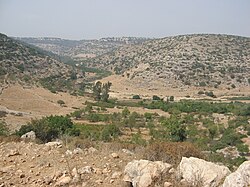Wadi Qana: Difference between revisions
→Archaeology: what both sources call it. |
m JungerMan Chips Ahoy! moved page Wadi Qana to Nahal Qana over redirect: previous move made w/o discussion and falsely claimed this is the "official name" |
(No difference)
| |
Revision as of 02:56, 6 May 2020
32°7′37.32″N 34°53′43.48″E / 32.1270333°N 34.8954111°E Wadi Qana or Qanah (Hebrew: נחל קנה Nakhal Qana) is an intermittent stream flowing west through the West Bank and Israel and into the Yarkon River, whose northernmost tributary it is.

Geography
Wadi Qana begins in the hills of Mount Gerizim, in the West Bank, flows in a general ENE-WSW direction and reaches the Sharon plain near Jaljulia, where it empties into the Yarkon just west of the Yarkon interchange (32°7′16.7″N 34°54′13″E / 32.121306°N 34.90361°E on Highway 5).
Wadi Qana runs through the West Bank south of Immanuel, Karnei Shomron, Ma'ale Shomron, Alfei Menashe, continues in Israel south of Nirit, Kfar Saba, and Hod HaSharon; and it flows north of the West Bank settlements of Yakir, Nofim, Etz Efraim, Sha'arei Tikva, Oranit, and of Kibbutz Horshim in Israel.
Archaeology
Nahal Qanah Cave
In 1980, speleologists from the Society for the Protection of Nature in Israel were told by villagers from Kafr Laqif in western Samaria about a karstic cave in the wadi.[1] The cave, located some 25 km east of Tel Aviv,[2] was hard to find and even harder to enter, but once inside they and a team of archaeologists discovered remains from three prehistorical periods: the Neolithic finds were the oldest, dating to c. 9000 years ago; from the Chalcolithic period (4th millennium BCE) they found human burials; and the most recent findings were from the Early Bronze Age (3rd millennium BCE).[3] The Chalcolithic burials made use of ossuaries and the deceased were interred along with funerary offerings, including pottery and objects made of gold, copper and ivory.[3] Eight circlets, two of them made of almost pure gold (89-98%) and six of electrum (c. 70% gold and 30% silver), weighing together almost a kilogram, were found next to one set of skeletal remains.[4] The researchers argued that the metal originated from mines in southern Egypt, geographically the nearest and altogether the most likely source,[2] and the look and size of the circlets (just under 5 cm outer diametre)[4], resembling late Egyptian pictograms, seem to indicate that they were ingots rather than jewelry.[2] They are the only gold objects from the Levant predating the Early Bronze Age,[2] the oldest ones found in Samaria, and among the oldest in the world.[4] The archaeologists who excavated the cave, Avi Gopher and Tsvika Tsuk, argue that the gold, found next to male human remains, must be seen as status symbols of the deceased.[2]
Hebrew Bible
Wadi Qana served as the boundary between the Tribe of Ephraim and the Tribe of Manasseh (Joshua 16:8).[5]
Nature reserve
As of 2006, the area around Wadi Qana is being considered as a nature reserve, as requested by the Israel Nature and Parks Authority. [6]
References
- ^ Gopher, Avi. "The Nahal Qanah Cave: Earliest Gold in the Southern Levant". Tel Aviv University. Retrieved 2019-12-27.
- ^ a b c d e "Chalcolithic: Industrial Arts". Encyclopedia of Prehistory. Vol. 8: South and Southwest Asia. Kluwer Academic/Plenum Publ. with Human Relations Area Files, Inc. 2003. pp. 60–61. ISBN 0-306-46262-1. Retrieved 2019-12-27.
{{cite encyclopedia}}: Unknown parameter|editors=ignored (|editor=suggested) (help) - ^ a b "Ancient Gold - Rare Finds from the Nahal Qanah Cave (exhibition, 29 Jan 1991 - 26 Apr 1992)". Israel Museum, Jerusalem. Retrieved 2019-12-27.
- ^ a b c Circlets. Nahal Qanah Cave, Western Samaria. Retrieved 2019-12-27.
{{cite book}}:|work=ignored (help) - ^ Weeks, John M.; de Medeiros, Jason (2014-11-25). A Research Guide to the Ancient World: Print and Electronic Sources. Rowman & Littlefield. ISBN 9781442237407.
- ^ "Nahal Qana" (in Hebrew). Israel Nature and Parks Authority. Retrieved May 9, 2011.
External links
- Eldad, Karni (October 16, 2011). נחל קנה: דו-קיום תיירותי בשמורת טבע בשומרון (in Hebrew).
